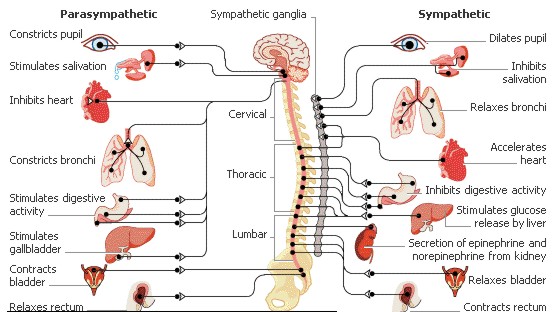|

The autonomic nervous system directs all activities of the body that occur without a person’s conscious control, such as heartbeat, breathing, and food digestion. It has two parts: the sympathetic division, which is most active in times of stress, and the parasympathetic division, which controls maintenance activities and helps conserve the body’s energy.
In an adult, resting heart rate is normally about 70 beats per minute. However, the heart can beat up to three times faster—at more than 200 beats per minute—when a person is exercising vigorously. Younger people have faster resting heart rates than adults do. The normal heart rate is about 120 beats per minute in infants and about 100 beats per minute in young children. Many athletes, by contrast, often have relatively slow resting heart rates because physical training makes the heart stronger and enables it to pump the same amount of blood with fewer beats. An athlete’s resting heart rate may be only 40 to 60 beats per minute.
Although the SA node generates the heartbeat, impulses from nerves cause the heart to speed up or slow down almost instantaneously (see Nervous System). The nerves that affect heart rate are part of the autonomic nervous system, which directs activities of the body that are not under conscious control. The autonomic nervous system is made up of two types of nerves, sympathetic and parasympathetic fibers. These fibers come from the spinal cord or brain and deliver impulses to the SA node and other parts of the heart.
Sympathetic nerve fibers increase the heart rate. These fibers are activated in times of stress, and they play a role in the fight or flight response that prepares humans and other animals to respond to danger. In addition to fear or physical danger, exercising or experiencing a strong emotion can also activate sympathetic fibers and cause an increase in heart rate. In contrast, parasympathetic nerve fibers slow the heart rate. In the absence of nerve impulses the SA node would fire about 100 times each minute—parasympathetic fibers are responsible for slowing the heart to the normal rate of about 70 beats per minute.
Chemicals known as hormones carried in the bloodstream also influence the heart rate. Hormones generally take effect more slowly than nerve impulses. They work by attaching to receptors, proteins on the surface of heart muscle cells, to change the way the muscle cells contract. Epinephrine (also called adrenaline) is a hormone made by the adrenal glands, which are located on top of the kidneys. Released during times of stress, epinephrine increases the heart rate much as sympathetic nerve fibers do. Thyroid hormone, which regulates the body’s overall metabolism, also increases the heart rate. Other chemicals—especially calcium, potassium, and sodium—can affect heart rate and rhythm.
|